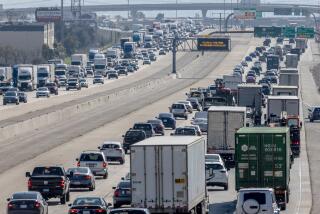Newton: Owens Valley dust-up
Los Angeles owes an old debt to the Owens Valley. It was there, a century ago, that representatives of this ambitious city quietly bought up water rights from unsuspecting farmers and then diverted the Owens River into a newly built aqueduct that brought Sierra snowmelt south and made Los Angeles possible. Owens Lake was emptied so that Los Angeles might prosper.
But how far does that debt extend? Is Los Angeles forever on the hook for the actions of its forefathers? And to the extent that it is possible to restore some of the Owens Valley, what would make it whole?
Those are the questions of law and history that undergird a lawsuit brought by the Los Angeles Department of Water and Power against the Great Basin Unified Air Pollution Control District, which oversees air quality in the Owens Valley. In it, the DWP alleges that it is facing excessive and unreasonable demands, and that it is now being forced to divert vast amounts of water to dampen dust in that mountain valley.
This is not a case of the DWP denying history. “We fully recognize that we have responsibilities,” DWP Chief Ron Nichols told me last week. “We’ve owned up to it.”
What he finds “unconscionable,” as he puts it, are the ever-increasing demands of the air pollution district and its chief officer, Ted Schade.
According to Nichols and the DWP lawsuit, Schade has continually moved the markers of success in the valley. What began in the late 1990s as a project to water down 11 square miles of lake bed became 29.8 square miles by 2003, 43 square miles in 2006 and just over 45 square miles last year. The amount of water being diverted from Los Angeles to that lake bed is now pretty staggering: The DWP uses about 95,000 acre-feet of water every year to flood the lake bed; that’s enough to supply all of San Francisco.
Schade, unsurprisingly, sees this issue differently. He argues that the DWP is required to do whatever it takes to bring down dust in the valley, dust that he says is the DWP’s responsibility.
“The city says we’ve moved the goal posts,” he said. “That’s absolutely not true.”
Instead, he maintains that the DWP has gone 90% of the way toward mitigating its historic damage to the Owens Valley, only to balk at the final increment. He also complains that the agency has failed to experiment with other methods of mitigation — gravel, foliage and the like — for a simple reason: “They get this water for free.”
There is no denying that the Owens Valley today is dusty. And there is no denying that the dried-up lake bed was, for many years, the source of much of that dust.
But Owens Lake was never Lake Tahoe. Long before the DWP existed, Owens Lake was a salty terminus to the river, growing in large snow years, drying up in spare ones. Newspaper reports collected by the DWP record dust storms in the 1870s that moved “the stoutest men to tears” and against which “ordinary houses afforded no protection.” That was before the DWP began siphoning off water for Los Angeles. It hardly seems fair that today’s DWP be required to make the valley less dusty than it was before the aqueduct.
As Nichols puts it, eliminating dust in the Owens Valley is “an absolute physical impossibility” and certainly not the job of a single water agency. He argues for a compromise that controls excessive dust but also limits the DWP’s open-ended responsibility. He has a point.
Finally, there is the larger context of water, which confronts the entire West. There is growing demand and limited supply. Farmers in the Sacramento-San Joaquin River Delta are braced for Los Angeles to draw water off the Sacramento River and potentially jeopardize their livelihoods. Western states such as Nevada are growing and are resentful of California’s claims on the Colorado River.
Los Angeles residents have done their part, engaging in decades of aggressive water conservation. Today, the average person here uses less water than the resident of any other American city of more than 1 million people, and the city overall uses less water than it did 40 years ago, despite significant growth.
But the thirst for water continues to grow in the Southwest, and efforts to secure and conserve it are serious, expensive and difficult. In the face of such cost and effort, it is “unconscionable” to flood a section of the high desert so that a place that was always dusty might no longer be.
Jim Newton’s column appears Mondays. His latest book is “Eisenhower: The White House Years.” Reach him at jim.newton@latimes.com or follow him on Twitter: @newton_jim.
More to Read
A cure for the common opinion
Get thought-provoking perspectives with our weekly newsletter.
You may occasionally receive promotional content from the Los Angeles Times.







